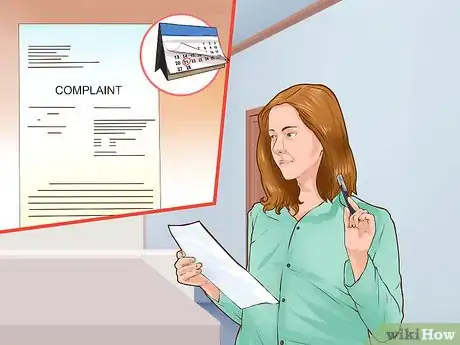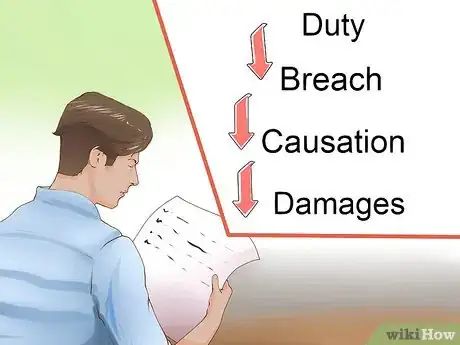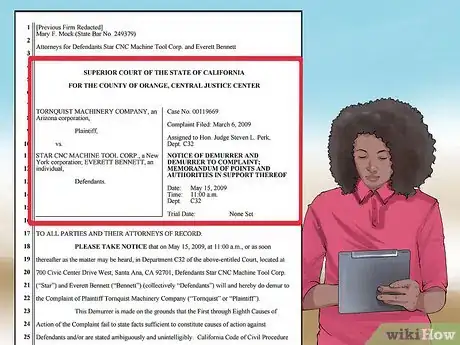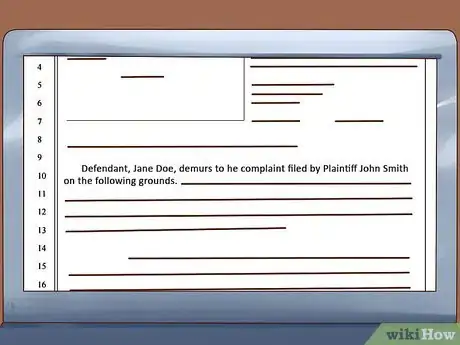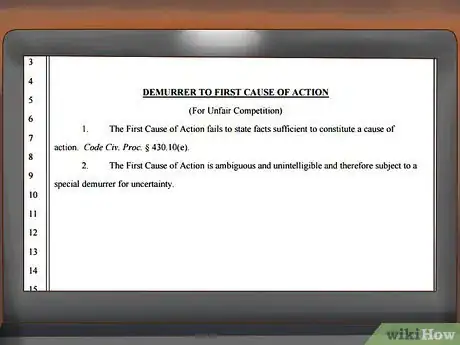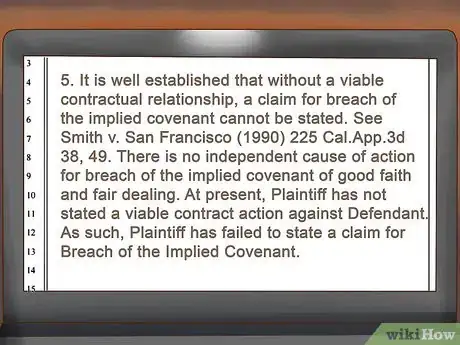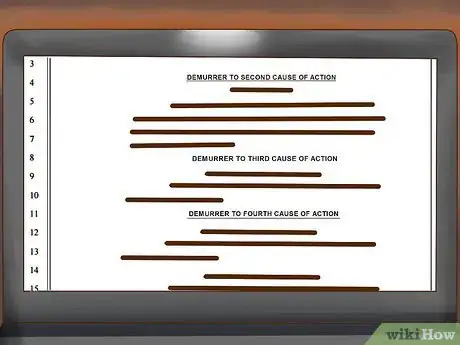This article was co-authored by Clinton M. Sandvick, JD, PhD. Clinton M. Sandvick worked as a civil litigator in California for over 7 years. He received his JD from the University of Wisconsin-Madison in 1998 and his PhD in American History from the University of Oregon in 2013.
There are 12 references cited in this article, which can be found at the bottom of the page.
This article has been viewed 22,396 times.
After the plaintiff starts a lawsuit by filing a complaint, you can respond by filing an “answer” or a “demurrer.” In a demurrer, you argue that the plaintiff has not stated a legitimate legal claim and ask that the judge dismiss the complaint.[1] To draft and file a demurrer, you need to become comfortable doing legal research. You will need to explain to the judge what the current law is and how the plaintiff’s complaint fails to allege sufficient information. In general, you should only file a demurrer in limited situations, most often when the statute of limitations bars a case from moving forward. In most other situations, a demurrer will not cause a lawsuit to be dismissed permanently. Instead, the court will usually allow the plaintiff to file an amended complaint in order to fix the error. If you have any questions about how to draft and file a demurrer, you should reach out to a lawyer.
Steps
Analyzing the Complaint
-
1Read the complaint. You will receive a copy of the complaint, usually by hand-delivery. You should take out a pencil and highlighter and read the whole document. Pay attention to why the plaintiff is suing you.
- Note the deadline that you have to respond. This may appear on the “summons,” which you should get along with the copy of the complaint. You have to file your demurrer before the deadline.
- If you fail to file the demurrer in time, then the judge might grant the plaintiff a default judgment against you. This means the plaintiff will win the lawsuit without you ever getting to defend yourself.[2] With a default judgment in hand, the plaintiff can possibly garnish your wages or put a lien on your property. For this reason, it is important to file the demurrer before the deadline.
-
2Read your state’s Rules of Civil Procedure. You can’t bring a demurrer in federal court. Instead, you will need to file a “Motion to Dismiss.” Only a minority of U.S. states allow demurrers. Find your state’s Rules of Civil Procedure online and read them. Check to see if you can file a demurrer in response to the complaint.
- Also write down what grounds you can raise in your demurrer. For example, California lets you raise nine different grounds for demurring from a complaint.
Advertisement -
3Research the causes of action. Each complaint contains at least one cause of action. For example, “breach of contract” is a cause of action. Other common causes of action include negligence, trespass, and medical malpractice. You should do some basic research on what the plaintiff must prove in each cause of action.
- For example, in order to bring a negligence claim, the plaintiff must prove that (1) you owed the plaintiff a duty of care, (2) you breached that duty, and (3) that duty caused (4) your damages.[3]
- You can do research at your nearest law library. It may be located at your local courthouse or the nearest law school.
- You can also search online. Search by state and cause of action. For example, if you are sued for negligence in Virginia, then search “Virginia negligence law.”
-
4Keep track of your legal citations. In your demurrer, you will need to tell the judge the statute or court opinion that explains the elements for each cause of action. As you do your research, be sure to write down the statute number or case name.
- You might find it easier to photocopy every court opinion or statute that appears relevant. In this way, you can go back through your papers to find the legal citations as you are typing up your demurrer.
- See Cite Legal Research for more information on citing to your legal research.
-
5Check to make sure the plaintiff has alleged all elements of a claim. The plaintiff does not have to prove anything in the complaint. However, he or she must make sufficient allegations which, if true, could support finding against you.
- For example, look to see that the plaintiff alleged all four elements of negligence. If the plaintiff forgot to allege that your breach “caused” their injuries, then the complaint is defective.
- In the typical demurrer, you will point out that the plaintiff did not allege all the elements for a cause of action.[4]
-
6Check that the plaintiff filed the lawsuit in the correct court. In some states, you can also demur on the grounds that the court does not have jurisdiction over the subject matter of the case. Courts are only empowered to hear certain disputes, and this power is called “jurisdiction.”
- Check whether the court has jurisdiction over the subject. Generally, many federal laws can be enforced in state courts, but a few may be brought only in federal courts. For example, cases involving copyright violations or patent infringement must be brought in federal court.[5] If the plaintiff filed in the wrong court, then you can raise this in your demurrer.
- Also check with your state’s Rules of Civil Procedure to see whether you can raise jurisdictional issues in a demurrer. In Virginia, for example, you cannot. Instead, you would have to file a separate “motion to dismiss.”[6] However, in California, you can raise subject matter jurisdiction in the demurrer.
-
7Meet with a lawyer. An experienced lawyer can help you understand whether or not you should file a demurrer. You can get a referral to an attorney by contacting your state or local bar association, which should help you find a qualified lawyer.[7]
- Once you have the name of a lawyer, call and schedule a consultation.
- Take your copy of the complaint and summons to show the attorney.
Drafting Your Demurrer
-
1Format your document. Your demurrer must appear in proper form. You can research your state’s requirements for pleadings by reading your state’s Rules for Civil Procedure. If your state doesn’t have specific rules, then find an example of a demurrer online that has been filed in your state and use that as a guide. You want your demurrer to look professional.
- Your court might require that the demurrer be printed on “pleading paper.” This is special paper that is numbered down the left-hand side. You can get pleading paper from an office supply store or you can download it from the Sacramento County Public Law Library website.[8]
-
2Insert a caption. The caption is the information that appears at the top of the document. It lists the parties, the court, the case number, and the judge’s name.[9] Look at the complaint. You can copy the caption information from there.
- Don’t forget to title your document also. You can title it “Demurrer to Complaint.”
-
3Insert the opening paragraph. Your opening paragraph should read, “Defendant, [insert your name], demurs to the complaint filed by Plaintiff [insert name] on the following grounds.”
-
4Identify the cause of action. You need to identify each cause of action and demur to each. Explain why you are demurring. Be sure to create a section heading for each cause of action. For example, you can type “Demurrer to First Cause of Action” in bold and underline. Underneath, you can put the cause of action in parentheses.[10]
- You then need to state the grounds for the demurrer. For example, you could write, “The First Cause of Action fails to state facts sufficient to constitute a cause of action.” Then insert the citation from your state’s Rules of Civil Procedure that allows you to raise this as a grounds for demurrer.
- You can also demur if the plaintiff fails to provide a copy of the contract in dispute.
- Your state also might allow you to make a special demurrer if the pleading is “ambiguous and unintelligible.”
-
5Explain what is missing from the complaint. After identifying why you demur, you should give the judge some idea of what the law currently is. Then you will need to point out what is missing from the plaintiff’s allegations.[11]
- For example, you could write, “It is well established that without a viable contractual relationship, a claim for breach of the implied covenant cannot be stated. See Smith v. San Francisco (1990) 225 Cal.App.3d 38, 49. There is no independent cause of action for breach of the implied covenant of good faith and fair dealing. At present, Plaintiff has not stated a viable contract action against Defendant. As such, Plaintiff has failed to state a claim for Breach of the Implied Covenant.”
- As you can see from this example, you first state what the law is. You also include your citation to the law. Then you state what is missing from the plaintiff’s allegations.
-
6Demur from all causes of action. If there is more than one cause of action you want to demur from, then you need to identify each one individually and explain why each one is insufficient. Use separate subject headings for each one: “Demurrer to Second Cause of Action,” “Demurrer to Third Cause of Action,” etc.[12]
-
7Request relief. After you have demurred to all of the causes of action you want to challenge, you need to request relief in your conclusion. You can type the following under the heading “Conclusion”:
- “For the foregoing reasons, Defendant respectfully requests that the Court grant its Demurrer.”[13]
-
8Add a signature block. At the bottom of the page, insert the date and then a signature line. Underneath the signature line, include your name and address.[14]
- Check if you need to have your signature notarized. Call up your court clerk and ask. If you need to have the demurrer notarized, then find a notary block for your state online and insert it beneath your signature block. Make sure to sign in front of the notary and show acceptable proof of identification (such as a valid passport or driver’s license).
Filing the Demurrer with the Court
-
1File the demurrer with the clerk. Make several copies of your demurrer. Take the original and all copies to the court where the complaint was filed. Ask the court clerk if you can file your demurrer. You may have to pay a filing fee, which will differ by court. If you can’t afford the filing fee, then ask the clerk for a fee waiver form and fill it out.[15]
- Also ask the clerk to stamp your copies with the filing date.
-
2Serve a copy on the plaintiff. If the plaintiff has a lawyer, then send the demurrer to the plaintiff’s lawyer. You should ask the court clerk for acceptable methods of service in your court.
- Generally, you can serve notice by having someone 18 or older hand deliver a copy on the plaintiff or their attorney. This person cannot be a party to the case.[16]
- Have the server fill out a “proof of service” (also called an “affidavit of service”) form and return it to you. You must file the original with the court. Keep a copy for your records.
-
3Schedule a hearing. When you file, you should also ask the court clerk about scheduling a hearing. The judge will want to hear argument on your demurrer. Each court handles the scheduling of hearings differently. For example, one court might have you fill out a Notice of Hearing form, which you will have to send to the plaintiff along with a copy of your demurrer.[17]
- If you fail to attend your hearing, then the judge can usually deny the motion without considering its merits. Accordingly, you should write down the hearing date and commit to attending.
References
- ↑ http://dictionary.law.com/default.aspx?selected=487
- ↑ https://www.law.cornell.edu/wex/default_judgment
- ↑ http://www.injuryclaimcoach.com/elements-of-negligence.html
- ↑ http://definitions.uslegal.com/d/demurrer/
- ↑ http://www.nolo.com/legal-encyclopedia/subject-matter-jurisdiction-state-federal-29884-2.html
- ↑ http://www.vsb.org/docs/valawyermagazine/vl0211_answer.pdf
- ↑ http://www.calbar.ca.gov/Public/Tips.aspx
- ↑ http://saclaw.org/wp-content/uploads/2015/03/form-fillable-pleading-paper.pdf
- ↑ http://documents.jdsupra.com/09dbeeb6-2810-4c0f-b2d3-be220799e27a.pdf
- ↑ http://documents.jdsupra.com/09dbeeb6-2810-4c0f-b2d3-be220799e27a.pdf
- ↑ http://documents.jdsupra.com/09dbeeb6-2810-4c0f-b2d3-be220799e27a.pdf
- ↑ http://documents.jdsupra.com/09dbeeb6-2810-4c0f-b2d3-be220799e27a.pdf
- ↑ http://documents.jdsupra.com/09dbeeb6-2810-4c0f-b2d3-be220799e27a.pdf
- ↑ http://documents.jdsupra.com/09dbeeb6-2810-4c0f-b2d3-be220799e27a.pdf
- ↑ http://www.occourts.org/self-help/civil/ihavebeensued.html
- ↑ http://www.occourts.org/self-help/civil/ihavebeensued.html
- ↑ http://www.courts.ca.gov/cms/rules/index.cfm?title=three&linkid=rule3_1320
